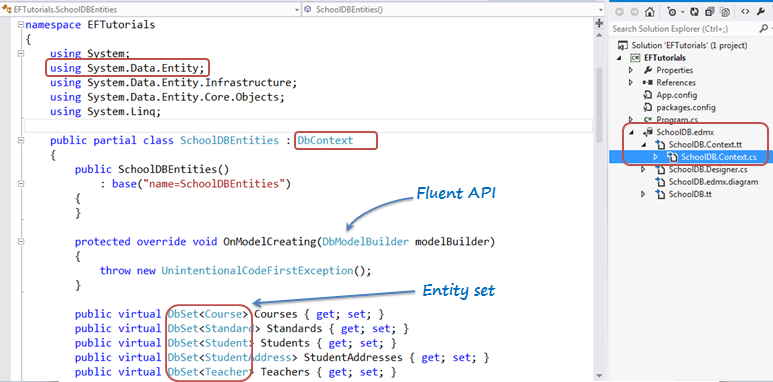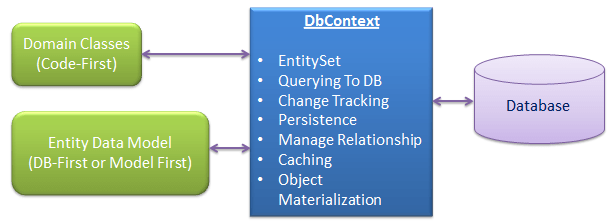Entity Framework Tutorial Basics(7):DBContext
DBContext:
As you have seen in the previous Create Entity Data Model section, EDM generates the SchoolDBEntities class, which was derived from the System.Data.Entity.DbContext class, as shown below. The class that derives DbContext is called context class in entity framework.

Prior to EntityFramework 4.1, EDM used to generate context classes that were derived from the ObjectContext class. It was a little tricky to work with ObjectContext. DbContext is conceptually similar to ObjectContext. It is a wrapper around ObjectContext which is useful in all the development models: Code First, Model First and Database First.
DbContext is an important part of Entity Framework. It is a bridge between your domain or entity classes and the database.

DbContext is the primary class that is responsible for interacting with data as object. DbContext is responsible for the following activities:
- EntitySet: DbContext contains entity set (DbSet<TEntity>) for all the entities which is mapped to DB tables.
- Querying: DbContext converts LINQ-to-Entities queries to SQL query and send it to the database.
- Change Tracking: It keeps track of changes that occurred in the entities after it has been querying from the database.
- Persisting Data: It also performs the Insert, Update and Delete operations to the database, based on what the entity states.
- Caching: DbContext does first level caching by default. It stores the entities which have been retrieved during the life time of a context class.
- Manage Relationship: DbContext also manages relationship using CSDL, MSL and SSDL in DB-First or Model-First approach or using fluent API in Code-First approach.
- Object Materialization: DbContext converts raw table data into entity objects.
The following is an example of SchoolDBEntities class (context class that derives DbContext) generated with EDM for SchoolDB database in the previous section.
namespace EFTutorials
{
using System;
using System.Data.Entity;
using System.Data.Entity.Infrastructure;
using System.Data.Entity.Core.Objects;
using System.Linq; public partial class SchoolDBEntities : DbContext
{
public SchoolDBEntities()
: base("name=SchoolDBEntities")
{
} protected override void OnModelCreating(DbModelBuilder modelBuilder)
{
throw new UnintentionalCodeFirstException();
} public virtual DbSet<Course> Courses { get; set; }
public virtual DbSet<Standard> Standards { get; set; }
public virtual DbSet<Student> Students { get; set; }
public virtual DbSet<StudentAddress> StudentAddresses { get; set; }
public virtual DbSet<Teacher> Teachers { get; set; }
public virtual DbSet<View_StudentCourse> View_StudentCourse { get; set; } public virtual ObjectResult<GetCoursesByStudentId_Result> GetCoursesByStudentId(Nullable<int> studentId)
{
var studentIdParameter = studentId.HasValue ?
new ObjectParameter("StudentId", studentId) :
new ObjectParameter("StudentId", typeof(int)); return ((IObjectContextAdapter)this).ObjectContext.ExecuteFunction<GetCoursesByStudentId_Result>("GetCoursesByStudentId", studentIdParameter);
} public virtual int sp_DeleteStudent(Nullable<int> studentId)
{
var studentIdParameter = studentId.HasValue ?
new ObjectParameter("StudentId", studentId) :
new ObjectParameter("StudentId", typeof(int)); return ((IObjectContextAdapter)this).ObjectContext.ExecuteFunction("sp_DeleteStudent", studentIdParameter);
} public virtual ObjectResult<Nullable<decimal>> sp_InsertStudentInfo(Nullable<int> standardId, string studentName)
{
var standardIdParameter = standardId.HasValue ?
new ObjectParameter("StandardId", standardId) :
new ("StandardId", typeof(int)); var studentNameParameter = studentName != null ?
new ObjectParameter("StudentName", studentName) :
new ObjectParameter("StudentName", typeof(string)); return ((IObjectContextAdapter)this).ObjectContext.ExecuteFunction<Nullable<decimal>>("sp_InsertStudentInfo", standardIdParameter, studentNameParameter);
} public virtual int sp_UpdateStudent(Nullable<int> studentId, Nullable<int> standardId, string studentName)
{
var studentIdParameter = studentId.HasValue ?
new ObjectParameter("StudentId", studentId) :
new ObjectParameter("StudentId", typeof(int)); var standardIdParameter = standardId.HasValue ?
new ObjectParameter("StandardId", standardId) :
new ObjectParameter("StandardId", typeof(int)); var studentNameParameter = studentName != null ?
new ObjectParameter("StudentName", studentName) :
new ObjectParameter("StudentName", typeof(string)); return ((IObjectContextAdapter)this).ObjectContext.ExecuteFunction("sp_UpdateStudent", studentIdParameter, standardIdParameter, studentNameParameter);
}
}
}
As you can see in the above example, context class (SchoolDBEntities) includes entity set of type DbSet<TEntity> for all the entities. Learn more about DbSet class here. It also includes functions for the stored procedures and views included in EDM.
Context class overrides OnModelCreating method. Parameter DbModelBuilder is called Fluent API, which can be used to configure entities in the Code-First approach.
Instantiating DbContext:
You can use DbContext by instantiating context class and use for CRUD operation as shown below.
using (var ctx = new SchoolDBEntities())
{ //Can perform CRUD operation using ctx here..
}
Getting ObjectContext from DbContext:
DBContext API is easier to use than ObjectContext API for all common tasks. However, you can get the reference of ObjectContext from DBContext in order to use some of the features of ObjectContext. This can be done by using IObjectContextAdpter as shown below:
using (var ctx = new SchoolDBEntities())
{
var objectContext = (ctx as System.Data.Entity.Infrastructure.IObjectContextAdapter).ObjectContext; //use objectContext here..
}
EDM also generates entity classes. Learn about the different types of entity in the next chapter.
Entity Framework Tutorial Basics(7):DBContext的更多相关文章
- Entity Framework Tutorial Basics(1):Introduction
以下系列文章为Entity Framework Turial Basics系列 http://www.entityframeworktutorial.net/EntityFramework5/enti ...
- Entity Framework Tutorial Basics(4):Setup Entity Framework Environment
Setup Entity Framework Environment: Entity Framework 5.0 API was distributed in two places, in NuGet ...
- Entity Framework Tutorial Basics(43):Download Sample Project
Download Sample Project: Download sample project for basic Entity Framework tutorials. Sample projec ...
- Entity Framework Tutorial Basics(42):Colored Entity
Colored Entity in Entity Framework 5.0 You can change the color of an entity in the designer so that ...
- Entity Framework Tutorial Basics(41):Multiple Diagrams
Multiple Diagrams in Entity Framework 5.0 Visual Studio 2012 provides a facility to split the design ...
- Entity Framework Tutorial Basics(37):Lazy Loading
Lazy Loading: One of the important functions of Entity Framework is lazy loading. Lazy loading means ...
- Entity Framework Tutorial Basics(36):Eager Loading
Eager Loading: Eager loading is the process whereby a query for one type of entity also loads relate ...
- Entity Framework Tutorial Basics(34):Table-Valued Function
Table-Valued Function in Entity Framework 5.0 Entity Framework 5.0 supports Table-valued functions o ...
- Entity Framework Tutorial Basics(33):Spatial Data type support in Entity Framework 5.0
Spatial Data type support in Entity Framework 5.0 MS SQL Server 2008 introduced two spatial data typ ...
随机推荐
- hihocoder#1148 : 2月29日 计算闰年的个数
计算到某年为止的闰年数,其实很简单.设要计算的年为A,则到A年为止(含A年)的闰年数为: 闰年数=INT(A/)-INT(A/)+INT(A/) 这里:INT为取整数函数 #include <c ...
- 导入的Android项目出现红色感叹号
[原因] 项目中存在导入包,在项目导入之后,classpath指向的包路径出现错误,即需要重新Bulidpath [解决方式] 右键项目名称 BuildPath —> Configure B ...
- MySQL下分页查询数据
-- 分页 -- 前两条 -- 启始位置从下标0开始,查询的是数据库中的第1条开始 -- 0:启始位置 2:一次性查询多少条 select * from account LIMIT 0,2; -- ...
- Communication System(动态规划)
个人心得:百度推荐的简单DP题,自己做了下发现真得水,看了题解发现他们的思维真得比我好太多太多, 这是一段漫长的锻炼路呀. 关于这道题,我最开始用DP的思路,找子状态,发现自己根本就不会找DP状态数组 ...
- queue容器
一.queue特性 queue是一种先进先出(first in first out,FIFO)的数据结构,它有两个口,数据元素只能从一个口进,从另一个口出.队列只允许从队尾加入元素,队头删除元素,必须 ...
- jsp有哪些动作?作用分别是什么?
jsp共有6种基本动作: 1.jsp:include,在页面被请求的时候引入一个文件 2.jsp:useBean,寻找或者实例化一个JavaBean 3.jsp:setProperty,设置JavaB ...
- Python numpy函数:transpose()
transpose用于对高维数组进行转置,转置时候需要一个由轴编号组成的元组. 比如说三维的数组,那就对维度进行编号,也就是0,1,2:这样说可能比较抽象.这里的0,1,2可以理解为对shape返回元 ...
- SQL简单嵌套查询与非嵌套查询的比较(MSSQL2005)
某天的工作是修复某个项目的bug,接着就发现,其sql极其混乱,有非常多的left join和in操作,还有嵌套查询(只有一个表的嵌套查询).不知道看到过哪里的资料说,嵌套查询速度慢,于是我把全部嵌套 ...
- JDK 8 - java.util.HashSet 实现机制分析
JDK 8 Class HashSet<E> Doc: public class HashSet<E> extends AbstractSet<E> impleme ...
- 第15届浙江省赛 D Sequence Swapping(dp)
Sequence Swapping Time Limit: 1 Second Memory Limit: 65536 KB BaoBao has just found a strange s ...
